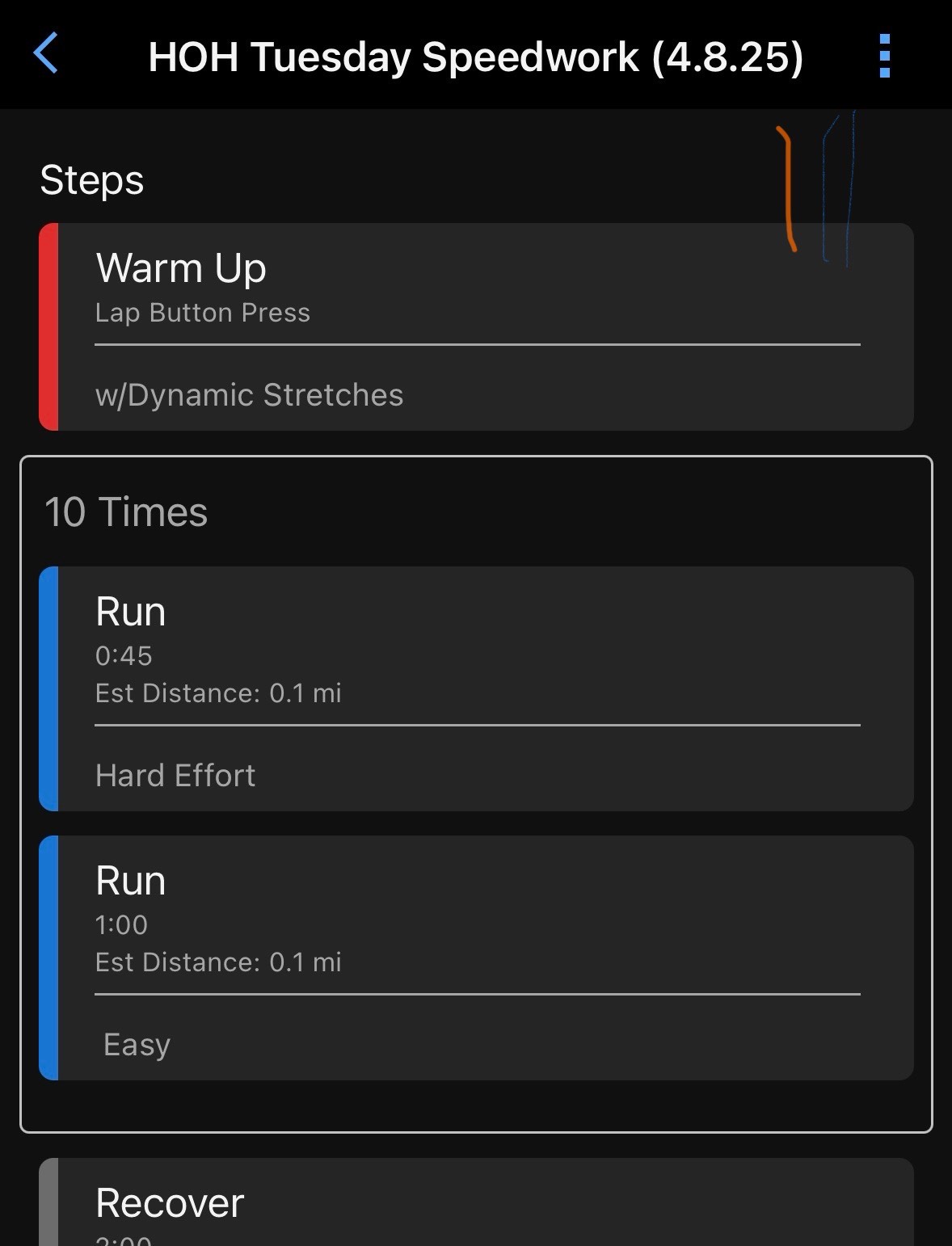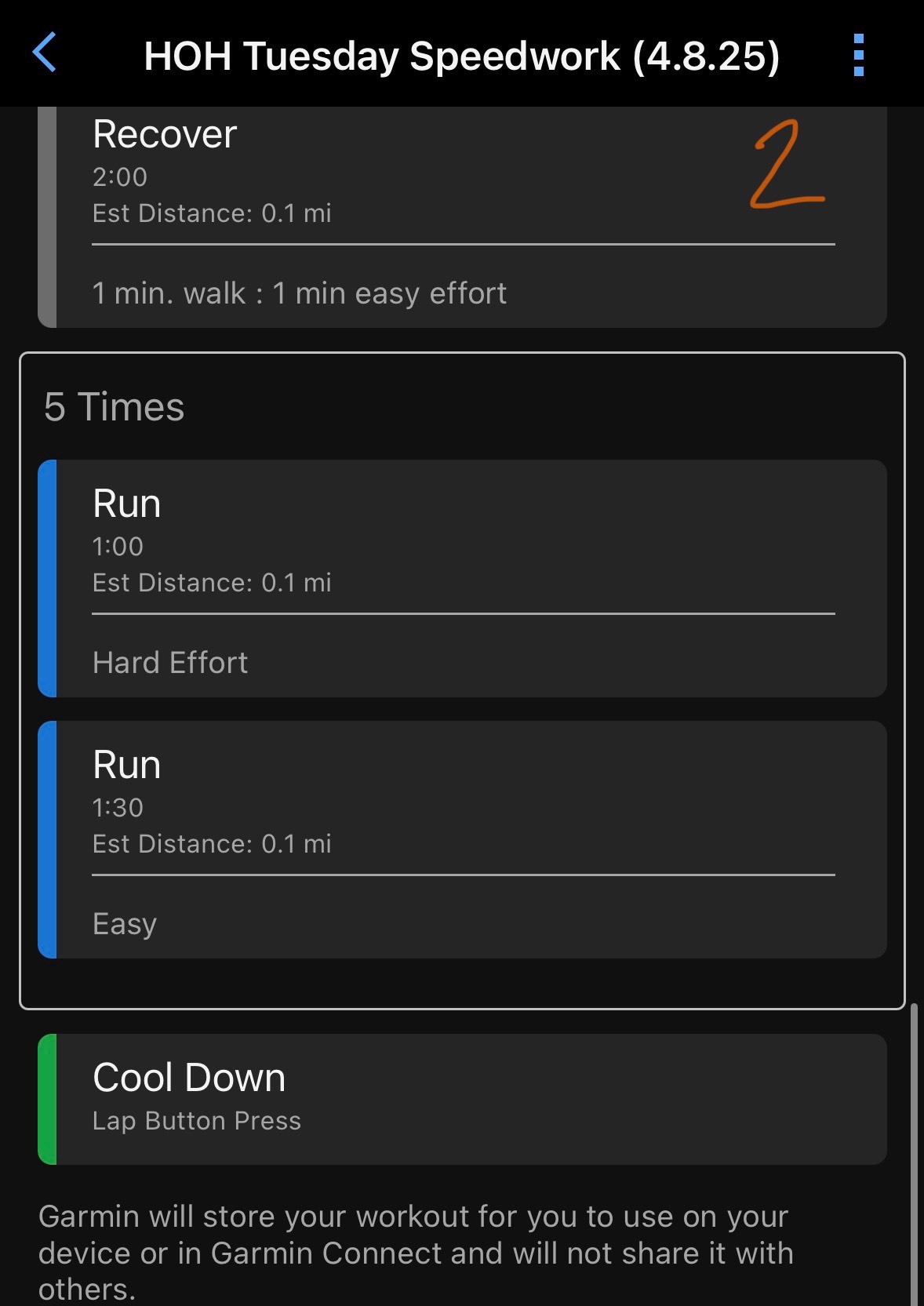Tuesday Workout (4.8.25)
Happy
Monday, team,
I hope your week is off to a great start!
We will be meeting at the playground entrance
of the Parkway tomorrow, ready to start our workout at 5:45pm. I
hope you didn’t put your winter running clothes away yet because unfortunately,
it looks like we should expect some cold, windy weather during our workout.
Thankfully, our short, hard-effort intervals will keep us nice and toasty! You
can find tomorrow’s workout along with 2 screenshots of how I programmed it
below. In anticipation of the weather, I have already modified
this workout, decreasing the number of repeats for both sets of intervals and
cutting the total time down by almost 10 minutes.
Tuesday
Workout (4.8.25):
Warm up w/dynamic stretches
10 times:
45 sec hard/60
sec easy
2 min recovery (1 minute walking:1 minute easy)
5 times:
1 min
hard/90 sec easy
Cooldown
Post-run Group Stretching
About the
workout:
- The easy intervals are scheduled as runs in my Garmin, and
therefore you should be easy jogging them. If you absolutely need to, you can begin
the easy intervals as a walk, but please try to only walk the first 10-15
seconds. Remember that Tuesday workouts are supposed to be hard and uncomfortable. Growth does
not occur in the comfort zone! - We will walk the first minute of the recovery but will easy jog
the second minute, before starting our next set of repeats. Remember to use
this recovery as a time to sip your water, adjust your posture, stretch, and
regulate your breathing. - Everyone is to circle to the back of the
group (or as close as possible) on the easy intervals and recovery. This
not only helps promote inclusion and a team atmosphere but allows me to check
in on everyone. - We will be stretching as a group after the workout. As you finish
your cooldown, please circle up and begin stretching.
COACH CHAT:
Quick Overview of Anaerobic Capacity:
The point of this workout (and many of our speed workouts) is to
push your anaerobic threshold by running multiple short, hard efforts with
small periods of rest between. These more intense intervals will help to
enhance your speed and build your anaerobic capacity over time.
What is
Anaerobic Capacity and What is the Benefit?
Anaerobic Capacity is the body’s ability to produce energy without
using oxygen during short durations of high-intensity activities. Unlike
running aerobically (such as our training runs we run at a conversational pace)
which uses oxygen to produce energy for longer durations, running anaerobically
does not use oxygen to produce energy. Instead, anaerobic running relies on the
body to break down carbohydrates (glycogen) stored in muscles to produce
energy. This energy production process creates lactic acid, a byproduct which
can cause muscle fatigue and soreness.
By training your anaerobic capacity, you help your body become
more efficient at handling that lactic acid buildup which will delay muscle
fatigue, allowing you to build up your endurance and push harder for longer
periods of time. Building your endurance will also improve your VO2 max (the
amount of oxygen you use while exercising), allowing you to increase your
cardiac fitness and pace. These improvements will allow you to become a more
efficient athlete.
While training your anaerobic capacity is valuable for improving
speed, power, and increasing your lactate threshold; anaerobic running can be
strenuous and lead to muscle damage. Therefore, it should be done in moderation
(only 20% or less of your runs should anaerobically) and with
proper warmups and cooldowns, before and after.
LOOKING
AHEAD:
Saturday
Long Run (4/12): Meet at the playground entrance of the Parkway
at 8:00am for the following distances:
4.5 or 5 miles: Mountain Goat Relay
7-8 miles: Shipyard Half
8 miles: Mountain Goat full
9-10 miles: Buffalo Half
Tuesday
Workout (4/15): Meet at Thornden Park at
5:45pm for our workout. I’ll send more information in Friday’s email.
EARTH DAY
CLEANUP:
With everyone training for different mileage, I am still trying to
determine which Saturday in April we should plan this so that it won't impact
anyone’s long runs, too much. Does anyone have a preference between April 12,
19, or 26? We could also push into May if that works better for everyone’s
training schedules. What are your thoughts?
PT CLINIC
WITH SOMA PT:
Diana has kindly spoken with her physical therapist who (provided
there is interest) is interested in hosting us for a PT clinic at their Fayetteville
location! It would likely be on a Tuesday evening, in place of our speedwork. Please
let me know if you would be interested in attending such an event, so we can
finalize the details.
Please make sure you are hydrating today and tomorrow and
consuming enough carb-rich (with some protein) calories to sustain tomorrow’s
workout.
I am so excited to see you all tomorrow evening!
Have a wonderful afternoon!
Coach Kristen


—